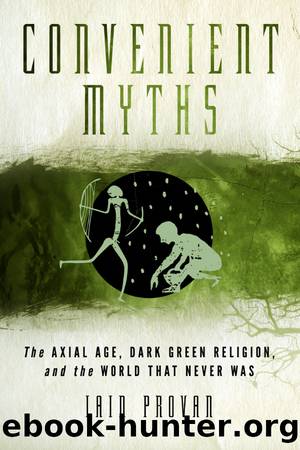Convenient Myths: The Axial Age, Dark Green Religion, and the World That Never Was by Iain Provan

Author:Iain Provan
Language: eng
Format: epub
Publisher: Baylor University Press
7
YOU CAN’T ALWAYS GET WHAT YOU WANT
Desire (and Need) and the Past
Unless there is some kind of spiritual revolution that can keep abreast of our technological genius, it is unlikely that we will save our planet.
—Karen Armstrong, The Great Transformation
Why couldn’t I—or any of my colleagues—see the magnitude and the implications of the warfare that was displayed before our eyes at El Morro? We were simply not conditioned to see it. The idea that all was peaceful long before writing in the ancient past was, and is, how most archaeologists and anthropologists see the world.
—Steven LeBlanc, Constant Battles
I have no doubt that many readers will have found the contents of chapters 2, 3, 5, and 6 surprising—even shocking. The stories that we have examined thus far in this book are widely believed to be true. It can be disconcerting (to say the least) to discover just how little they are based on evidence and how much evidence indeed stands against their veracity. It should be disconcerting to find out (at least in the case of the myth of the dark green golden age) how long this has been known by serious scholars to be the case and yet how little impact this knowledge appears to have had on believers. And this brings us to a puzzle. How is it that so many well-meaning people—indeed, so many smart, passionate, virtuous people—could have come to believe these two stories?
By way of getting to an answer to this question, let me recount an incident recalled by anthropologist Alice Ingerson from a course she once taught through Duke University’s anthropology department:
Many students enrolled in the course because they hoped to read about primitive or “first” peoples living “in harmony with nature.” But when one student realized how difficult it was going to be to document any past harmony between culture and nature she broke into tears in my office, confessing that she didn’t think she wanted to learn what she was going to learn in this class.1
Ingerson’s story illustrates a perennial danger in human intellectual activity regarding the past. It is the danger that desire, and in fact need—more than evidence—will drive our reconstruction of the past. It is the danger that evidence itself will become unwelcome, insofar as it disturbs our settled understanding of the world. Desire and need will dominate the enquiry, and evidence may not seriously even be sought. Then, when evidence comes across our radar screens anyway, it will be ignored. It may even be repressed so that others cannot gain access to it. For we are committed to imagining the past that we desire, or need, in order to make sense of our lives and to provide ourselves with some underlying authority that might ground our present and future agendas. We are committed to the past as we need and want it to be; we are no longer interested in the past as it was.
The occasions, historically, upon which human beings and human societies have fallen prey to this
Download
This site does not store any files on its server. We only index and link to content provided by other sites. Please contact the content providers to delete copyright contents if any and email us, we'll remove relevant links or contents immediately.
The Lost Art of Listening by Michael P. Nichols(6485)
Why I Am Not A Calvinist by Dr. Peter S. Ruckman(3774)
The Rosicrucians by Christopher McIntosh(3058)
Wicca: a guide for the solitary practitioner by Scott Cunningham(2711)
Signature in the Cell: DNA and the Evidence for Intelligent Design by Stephen C. Meyer(2506)
Real Sex by Lauren F. Winner(2482)
The Holy Spirit by Billy Graham(2427)
To Light a Sacred Flame by Silver RavenWolf(2358)
The End of Faith by Sam Harris(2297)
The Gnostic Gospels by Pagels Elaine(2034)
Nine Parts of Desire by Geraldine Brooks(2011)
Waking Up by Sam Harris(1962)
Heavens on Earth by Michael Shermer(1959)
Devil, The by Almond Philip C(1906)
Jesus by Paul Johnson(1893)
The God delusion by Richard Dawkins(1857)
Kundalini by Gopi Krishna(1828)
Chosen by God by R. C. Sproul(1766)
The Nature of Consciousness by Rupert Spira(1693)
